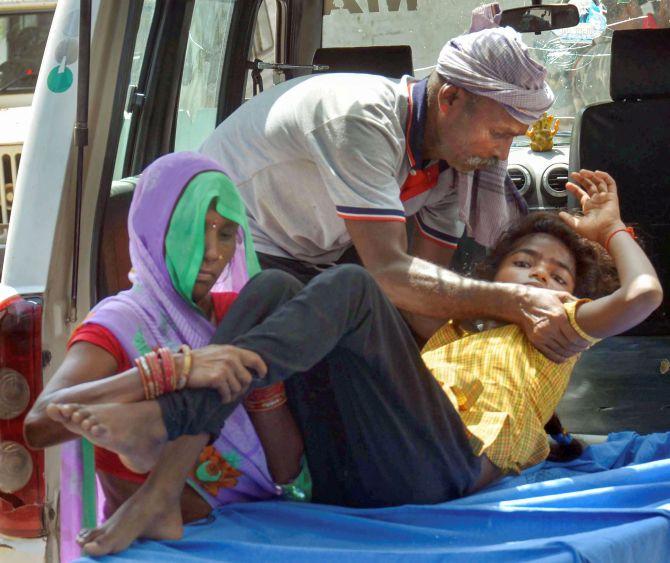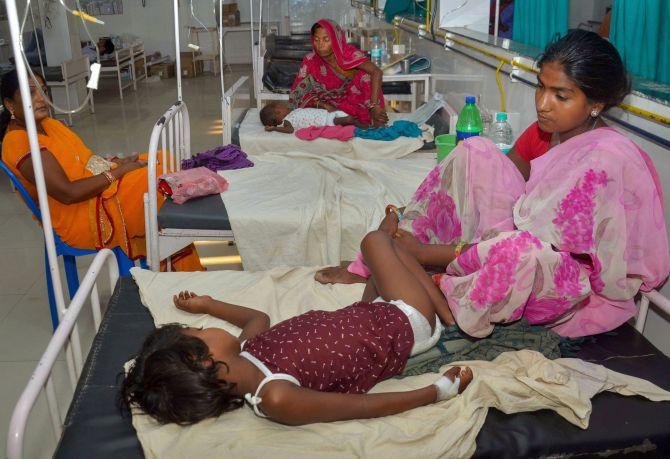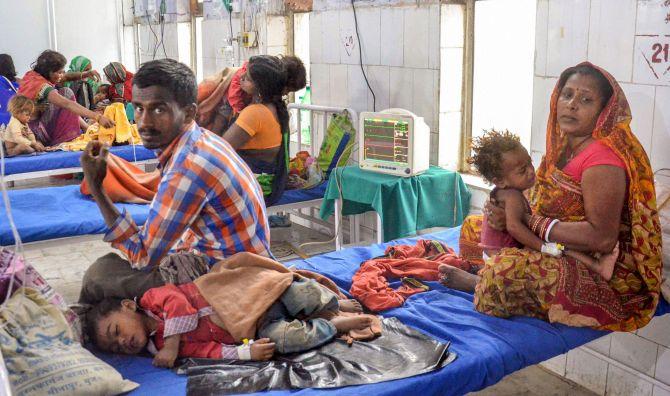An entirely preventable disease claimed the life of 173 children -- thanks to state apathy.
Satyavrat Mishra reports.

Bihar Chief Minister Nitish Kumar was smiling as he faced questions from journalists on June 10. Everyone was curious about the recent rift between the Janata Dal-United and the Bharatiya Janata Party.
Then, a question about the outbreak of Acute Encephalitis Syndrome popped up, and suddenly his face became rigid.
'This disease generally breaks out ahead of the rains. The department had taken steps to contain it. In the last few years, we have started awareness programmes, advising people not to let their children sleep without adequate food and water. However, there seems to be some slackness about these programmes as the cases are still coming up this year,' Kumar told the gathering.
He also sought further details from the health department's Principal Secretary Sanjay Kumar. The official assured that necessary arrangements had been made in hospitals in and around Muzaffarpur, the epicentre of the outbreak.
'So far, 10 children have died due to hypoglycaemia (extremely low levels of sugar in blood). We hope the disease would be controlled after the onset of rains,' the official told the chief minister.
These claims were laid bare within a week.
By the evening of June 15, more than 70 children had died in Muzaffarpur alone.
Its two big hospitals --- the Srikrishna Medical College Hospital (SKMCH) and the Kejriwal Maternity and Children Hospital -- were overwhelmed with patients, 280 new cases were detected, and panic had engulfed the state.
The SKMCH -- which has a nine-bed paediatrics intensive care unit (PICU) and a 20-bed paediatric ward -- was not ready to handle this kind of influx.
The whole system crumbled as bodies piled up.
With the situation spiralling out of control, Union Minister for Health Harsh Vardhan paid a visit to SKMCH along with his Minister of State Ashwini Choubey and Bihar Health Minister Mangal Pandey.
Incidentally, Choubey had earlier cancelled a review meeting on AES on June 12 because he had to attend a 'victory march' in his hometown of Bhagalpur to celebrate his election win.
The visit proved to be a publicity nightmare for the government.
During a crucial review meeting on the situation, Choubey was dozing off and Pandey was constantly asking about the cricket score. Nothing much came from the Union minister either.
Vardhan virtually repeated the same promises that he had made five years ago in 2014, while questions about accountability went unanswered.
A day later, the state government, however, swung into action. Three new PICUs were created in SKMCH. Primary health centres were operationalised. Ten doctors from Patna and Darbhanga were sent by the state government, and ambulance services and free treatment for AES patients were announced.
By that time, the death toll had crossed 100.
Chief Minister Kumar finally visited Muzaffarpur on June 18 where he had to face the wrath of people. Many shouted 'Nitish Go Back' and waved black flags.
Hours later, Chief Secretary Deepak Kumar for the first time admitted that the government was clueless on the cause of the disease.

In Dariyapur Mushari, under Kanti block of Muzaffarpur, there are 60 to 70 Mahadalit homes. The hamlet lost two children.
"There was a mundan ceremony in our extended family on June 12. My four-year-old son Prince liked such big ceremonies. We ate lunch there and returned home that same evening. He and his sisters had samosas on the way. He slept early that evening and began convulsing in the morning," said Nunu Mahto, Prince's father.
"We immediately took him to Kejriwal Hospital, but they couldn't save him. He died in the early hours of June 14."
"He was the apple of my eyes. How will I live now?" asked an inconsolable Shiela Devi, Prince's mother, tears rolling down her face. Her daughters were quiet as they sat beside their mother. The kitchen was empty and the earthen chulha had barely been used in days.
Devi isn't only one in this village to have lost a child to AES. Subodh Paswan and his wife Rekha's six-year-old Nidhi also succumbed to this disease on June 13.
"She got up early as usual and even went to a nearby shop with me to buy some provisions for the house. All of a sudden, she started convulsing. Her father took her to the nearby primary health centre on a motorcycle. They referred her to the big hospital in Muzaffarpur. She died that evening," Rekha narrated the last day of her daughter as she fought back tears.
AES also took the lives of two cousins -- two-year-old Rajkumar and 18-month-old Prince in the nearby Rampur Sah village.
"Nobody had told us anything. We didn't know what to do when my Raju started shaking with fever. We took him to a quack, but he died on the way. If I knew what to do, my son would have been alive," said Rajkumar's mother Chinta Devi.
Prince was her sister-in-law Sunita Devi's son. He died the next day. "What can I say? He had his milk, but didn't want to sleep. He wanted to play with me, but I was busy. He didn't wake up again," said his father Sunil Majhi.
These are just four of the 173 families besieged by unbearable grief and paying the price of government apathy towards them.
Most of these deaths were attributed to hypoglycaemia or extremely low levels of blood sugar. The state government, however, still does not know the exact cause of the AES, commonly known as brain fever or chamki bukhar.
According to doctors, AES causes inflammation of the membrane of the brain that leads to sudden onset of high fever that can cross 104 to 105 degrees Fahrenheit, acute headaches, vomiting, tremors, convulsions and paralysis.
Government officials have been blaming the summer fruit litchi, intense heat and lack of awareness about the disease for the outbreak. They, however, have not been able to zero in on one cause with certainty.
"There are a lot of theories. We don't know the cause for sure," said Chief Secretary Deepak Kumar.
Doctors and experts say the disease is multi-factorial, meaning AES can be caused by a combination of several factors.

"We need good laboratories and skilled professionals to ascertain the cause. The state government must conduct a detailed survey about the families of the children," said clinical scientist Dr Gagandeep Kang, the first Indian woman Fellow of Royal Society and executive director at the Translational Health Science and Technology Institute, Faridabad.
"Heat, poor hygiene and malnutrition are the key reasons," said Dr Arun Shah of the Indian Association of Paediatrics.
Dr Shah is based in Muzaffarpur and he has been keeping a close eye on AES for the past 20 years. He was part of a team led by paediatrician and virologist Dr Jacob John that carried out extensive research into AES. The team played an important role in putting down standard operational procedures for AES cases by the state government.
"The government's focus has been on litchi, but it is not right. In our research, we found that raw or rotten litchis do contain a toxin called MCPG. It might be a triggering factor, but not the only one," Dr Shah added.
"The real cause might lie in the malnourishment coupled with heat and humidity. Almost all the children, who succumbed to the disease, belong to the poorest of the poor families," Dr Shah said.
"In a normal person, a sudden fall in glucose level can be compensated with reserved glucose in the body. A malnourished child, however, doesn't have this reserve, thus the child falls prey to the disease."
At the Srikrishna Medical College Hosptial the mood is remarkably stark. There are sick children, worried parents and under pressure doctors everywhere.
"There is so much pressure on us," said a doctor at the hospital as he attended to patients.
As Dr Sunil Kumar Shahi, the superintendent of SKMCH, juggled one phone call after another, he could not hide his frustration.
"The hospital is working beyond its full capacity. Our doctors are working round-the-clock. We are trying our level best. You want to do a news story, do it on primary health centres. All we need is freedom from distractions," said Dr Shahi.
"At this time, we have 100 AES patients under treatment in our hospital. The total strength of our paediatric department is 21 doctors. Plus, 10 doctors have been sent by the state and central governments. More doctors are still needed. However, the real problem is the shortage of nurses and paramedical staff. We need at least one nurse on a couple of patients," said a senior resident doctor.
The department has 21 doctors and 6 nurses and no paramedical staff.
The situation is worse at the paediatric ward. The large hall is jam-packed with people. Children could be heard screaming due to the heat and humidity.
"It was to be air-conditioned last year. Therefore, all the windows were sealed off, but AC units could not be purchased because of lack of funds, thus the heat and humidity," said a doctor.
Yet, the occasional word of support that doctors hear comes from patients.
"Despite all the problems at the hospital, they have treated my son well. They are keeping a close eye on him. Hopefully, he would recover soon," said Ravi Rai, father of seven-year-old Hari Kishan.
"Doctors are doing a commendable job, it's the system that failed us," said Jammuludin Ansari from the nearby Sitamadhi district, whose nephew Alam is in the PICU. "Nobody told us anything. They were more focused about our votes than our children."

The death of children in Muzaffarpur has highlighted what was known all along: The crumbling health infrastructure of Bihar.
"The outbreak could have been easily managed at the primary health centres. However, the whole system came crashing down because of lack of properly functioning primary centres," said one of the doctors at SKMCH.
Out of the 1,719 villages in Muzaffarpur, only 630 have a health centre, according to data from the ministry of health and family welfare. It renders almost 80 per cent of the villages virtually defenceless against any disease.
Out of the total 103 PHCs in the district, not a single one got a rating better than a zero on an evaluation done by the ministry's Health Management Information System.
In fact, 98 PHCs did not even qualify for an evaluation as they lacked even the basic facilities.










